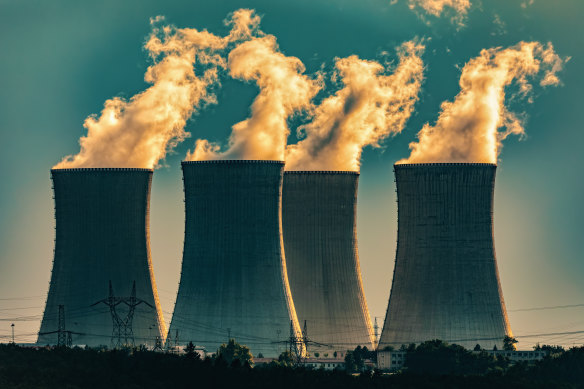Australia’s green power switch may cost more than first thought: CSIRO
By Nick Toscano
Moving from a coal-dominated power grid to cleaner sources of energy may end up costing more than first thought, as CSIRO warns of higher construction costs hitting the industry and giant premiums involved in developing new generation technologies, including offshore wind farms, for the first time.
However, the national science agency’s latest energy cost report card, to be released on Tuesday, confirms renewable energy generators remain the lowest-cost technologies available for the required transformation and expansion of the system – even when factoring in the cost of batteries that back up wind and solar farms, and the rollout costs of building transmission links to connect far-flung renewables to major cities.

The Coalition went to the last election proposing to build seven state-owned nuclear power plants across the country.Credit: Getty Images/iStockphoto
The report also debunks key claims the Coalition has relied on about the cost advantages of adopting nuclear energy in Australia, including large-scale nuclear power stations and small modular reactors, which CSIRO said were two of the most expensive technology options.
Small modular reactors “remain the highest-cost option”, CSIRO said, even after accounting for new data available on the construction costs of Canada’s Darlington project – the first commercial-scale Western project to provide a cost evidence base.
Nuclear would also incur the biggest cost premiums among the “first-of-a-kind” technologies that had not previously been used in Australia, CSIRO found. The first large-scale nuclear plant would cost 120 per cent more to build, it said, while the second would cost 60 per cent extra. A small modular reactor would cost an additional 92 per cent for the first plant and 46 per cent for the second.
Advocates of nuclear energy, including many in the federal Coalition, last year slammed CSIRO for finding renewables were the cheapest form of electricity, and asked it to redo its modelling.
The Coalition demanded CSIRO redo its modelling to acknowledge a nuclear plant would be in near-constant use – generating power 93 per cent of the time – while also extending its assumed lifespan from 30 years to more than 60 years.
In its new report, CSIRO said it found there were “no unique cost advantages arising from nuclear technology’s long operational life”. “Similar cost savings are achievable from shorter-lived technologies, even accounting for the fact that shorter lived technologies need to be built twice to achieve the same operational life,” it said.
In response to calls for CSIRO to model nuclear’s average capacity factor – the ratio of how long a generator is operational compared to sitting idle – in line with the US average of 93 per cent, CSIRO said it favoured the use of Australian evidence where available. The comparable experience of Australia’s baseload coal-fired generation fleet was 59 per cent, it said.
The Albanese government said the CSIRO’s closely watched GenCost report confirmed its plan for the energy transition was the “right plan for Australian homes and businesses”.
As Australia’s coal-fired power stations near the end of their lives, the government is aiming to deliver a mostly renewable grid, backed up by thousands of kilometres of extra transmission lines, storage assets such as batteries and pumped hydroelectric dams to stash clean energy for when it’s not sunny or windy, and a critical fleet of gas-fired power stations on standby.
“The latest GenCost confirms what our energy experts have been saying for a long time: the most affordable path to deliver reliable energy in future is with new renewable generation and storage, firmed by gas and pumped hydro,” Energy Minister Chris Bowen said.
Still, the report adds to deepening concerns about the cost of building a cleaner and bigger electricity grid, and the risk that consumers may be hit with higher bills to pay for it.
Installation costs, which typically account for about a third of a project’s overall cost, are rising for all energy technologies, CSIRO said. The report warns of installation cost increases of six per cent to 20 per cent by 2050, due to construction wage rises and the higher costs of materials, such as cement.
Gas turbines are in tight supply across the world, keeping prices elevated, the report says. It also adds to worries about the escalating cost of building Australia’s first offshore wind farms, which the governments are hoping can bring vast amounts of clean power to homes and businesses within the next decade.
However, the offshore wind sector has been reeling from rising interest rates, soaring equipment costs and supply chain disruptions, forcing the cancellation of projects around the world.
Now, GenCost warns that the first Australian offshore wind farm would incur a first-of-a-kind cost premium (the added cost needed to develop the new technology locally) of 63 per cent.
CSIRO’s director of energy, Dietmar Tourbier, said the GenCost represented Australia’s most comprehensive cost projections that would feed directly into system modelling and investment planning to support “evidence-based decisions across the sector”.
“By drawing on expert input from across the electricity sector, GenCost reinforces CSIRO’s role as a neutral source of scientific insight to help guide Australia’s energy transition,” he said.
The Business Briefing newsletter delivers major stories, exclusive coverage and expert opinion. Sign up to get it every weekday morning.